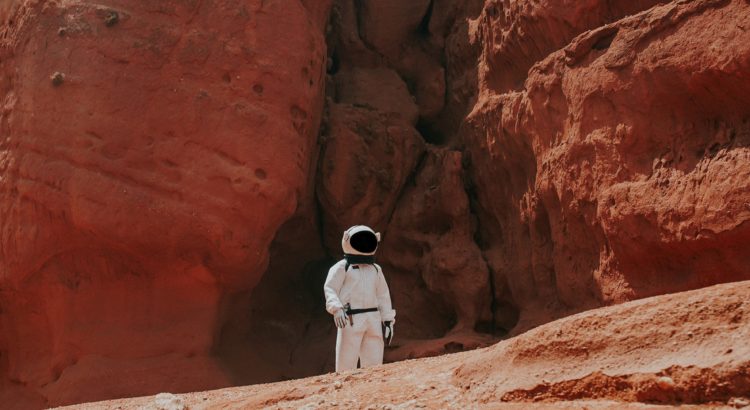Level B1 and above
Chances are, one of you is going to Mars.
Several public space agencies – NASA, ESA, Roscosmos, ISRO and the CNSA – and private organisations – SpaceX, Lockheed Martin, and Boeing – are researching the Mars mission project. The consensus is that we will be able to colonise Mars in the 2030s or 2040s.
Written and compiled by Benedicte Gravrand, English trainer at The Language House
If you have read The Martian, an excellent science fiction book by Andy Weir – or watched the movie, which is for once just as good as the book – you’ll know that moving to Mars is not like moving to Texas. You will need more than a suitcase and a green card. You will need oxygen, fuel, water, food, seeds to grow food, building material, spacesuits, and much more. You will also need patience. It will take about nine months to get there. And you will need mementos of Earth, as this will be a one-way trip (no return).
Mars is a chance to build a new culture. People will lead a different kind of life, with different temperatures, lower gravity, different types of housing, different skies and longer years. Children born on Mars will be Martians.
The experiment could go well or it could go wrong. I hope I’ll still be alive to see the intrepid souls go on that great voyage to new territories.
To subscribe to our blog, leave your email address (right-hand side column)
and confirm your subscription when you receive our email
What you need to know about Mars
Mars and Earth: a friendly comparative guide
Let’s compare Mars and Earth and the rest of the solar system.
Grammar: Comparatives and superlatives – general rules
To make a comparison using small adjective (one syllable), add -er (or -ier) at the end of the adjective and “than”:
- Mars is smaller than Earth
- I am feeling happier now
If you use a longer adjective (two syllables or more) in a comparison, add “more” and “than”:
- Mars is more interesting than Mercury
Use “the” in a comparison to show that one thing depends on another:
- The colder it gets, the more dangerous it becomes
In superlatives, add -est (or -iest, as in “happiest”) at the end of smaller adjectives, or add “the most” or “the least” in front of longer adjectives. “Most” is the superlative form of “much” and “many”; “least” is the superlative form of “little”.
- The lowest temperature on Mars is -140°C
- Mars is the most interesting planet in the solar system
- Pluto is the least luminous planet
- Patrick does the least work in the office (“less” or “the least” are used with uncountable nouns, like money, water, etc.)
- He makes the fewest mistakes (“fewer” or “the fewest” (few: some, but not many) are used with countable nouns) – NOT “he makes the least mistakes”.
Please note, as well as “little” and “much/many”, these adjectives are irregular:
- Good: Mars is better than Mercury; Mars is the best (planet)
- Bad: Pluto is worse than Neptune; Pluto is the worst
- Far: Mars is farther away from the Sun than Earth is; Pluto is the farthest (or further/furthest)
If the last letter of the adjective is a consonant (b, d, g, t, etc.), it is doubled (example: big, bigger, the biggest):
- Mars is the reddest planet of the solar system
We use “as” + adjective/adverb + “as” to compare things that are equal. Use “not as” to compare things that are not equal:
- The weather this summer is as hot as last year
- Mars is not as big as Earth
We can use “like” (a preposition) to say some things are similar.
- Poles on Mars are covered with ice, just like the poles on Earth
We can use “whereas” (a conjunction) to compare differences:
- Mars has two moons whereas Earth only has one
Practice your comparatives and superlatives:
Fill in the gaps with the appropriate adjectives, choosing from the list below, in the comparative or superlative form, or with “like” or “whereas”. The first one has been done for you as an example.
__________________________________________________
Small (x2) red like whereas little high low
high thin long high large studied
__________________________________________________
- Mars is the fourth planet from the Sun; Mercury, Venus and Earth are closer to the Sun than Mars
- Mars is the second … planet in the solar system; Mercury is … … . Mars is a sixth of Earth’s volume
- Mars has two moons, Phobos and Deimos, … Earth has only one moon
- The surface gravity on Mars is … than the surface gravity on Earth; that means you could jump three times as … on Mars, and if you weigh 50 kg on Earth, you would weigh only 19 kg on Mars.
- A year on Mars is … … a year on Earth, almost twice as long; it is equivalent to 687 Earth-days
- … … temperature on Mars is -140°C (degrees centigrade)
- … … temperature is +30°C
- The atmosphere on Mars is … … that on Earth: carbon dioxide (CO2) makes up 96% of the atmosphere, and 0.0415% on Earth
- Sunsets on Mars are blue, while during the day, the sky is pinkish-red
- On Mars, the Sun appears about half the size it does on Earth
- The poles on Mars are covered with ice, just … on Earth
- … … mountain in the solar system – as far as we know – is on Mars; it is called Olympus Mons; it is 21km high and 600km in diameter
- Mars has … … dust storms in the solar system. They can last for months and cover the entire planet
- 60 missions (including orbiters, landers and rovers) have been sent to Mars. So far, only 28 have reached their target. Currently, three missions are on their way to Mars. That’s because Earth and Mars are relatively close at the moment.
- Mars is … … planet of the solar system. The ancient Greeks called the planet Ares after their god of war; the ancient Romans then did likewise, associating the planet’s blood-red colour with their own god of war Mars. Interestingly, according to Space Facts, other ancient cultures also focused on colour – to China’s astronomers it was ‘the fire star’, while Egyptian priests called it ‘the red one’. The red colour on Mars is due to the surface being rich in iron oxide.
- Mars is … … … planet of the solar system – except, of course, for Earth.
_____________
Check your answers
- Mars is the fourth planet from the Sun; Mercury, Venus and Earth are closer to the Sun than Mars
- Mars is the second smallest planet in the solar system; Mercury is the smallest. Mars is a sixth of Earth’s volume
- Mars has two moons, Phobos and Deimos, whereas Earth has only one moon
- The surface gravity on Mars is less than the surface gravity on Earth; that means you could jump three times as high on Mars, and if you weigh 50 kg on Earth, you would weigh only 19 kg on Mars.
- A year on Mars is longer than a year on Earth, almost twice as long; it is equivalent to 687 Earth-days
- The lowest temperature on Mars is -140°C (degrees centigrade)
- The highest temperature is +30°C
- The atmosphere on Mars is thinner than that on Earth: carbon dioxide (CO2) makes up 96% of the atmosphere, and 0.0415% on Earth
- Sunsets on Mars are blue, while during the day, the sky is pinkish-red
- On Mars, the Sun appears about half the size it does on Earth
- The poles on Mars are covered with ice, just like on Earth
- The highest mountain in the solar system – as far as we know – is on Mars; it is called Olympus Mons; it is 21km high and 600km in diameter
- Mars has the largest dust storms in the solar system. They can last for months and cover the entire planet
- 60 missions (including orbiters, landers and rovers) have been sent to Mars. So far, only 28 have reached their target. Currently, three missions are on their way to Mars. That’s because Earth and Mars are relatively close at the moment.
- Mars is the reddest planet of the solar system. The ancient Greeks called the planet Ares after their god of war; the ancient Romans then did likewise, associating the planet’s blood-red colour with their own god of war Mars. Interestingly, according to Space Facts, other ancient cultures also focused on colour – to China’s astronomers it was ‘the fire star’, while Egyptian priests called it ‘the red one’. The red colour on Mars is due to the surface being rich in iron oxide.
- Mars is the most studied planet of the solar system – except, of course, for Earth.
The Martian – official trailer


